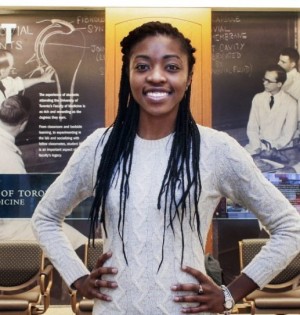
When Dr. Lisa Robinson graduated from the University of Toronto’s medical school in 1991, she was one of two black students in her class.
Twenty-six years later, Chika Oriuwa is the only one in her class of 259 first-year medical students who identifies as black.
Given the diversity of the GTA and the patients these future physicians will be treating, “I guess I was a bit taken aback by that,” says Oriuwa, 23, of Brampton.
So is the university, which on Wednesday announced an initiative aimed at boosting the chronically low number of black students who apply to medical school and go on to become doctors.
“It’s exciting, we’re the first program of this kind in Canada,” says Robinson, chief diversity officer with the faculty of medicine and a physician at Sick Kids Hospital.
“In this day and age in a city like Toronto, we want a class that reflects our population.”
Research shows that diversity in the field leads to better doctors with more cultural awareness and sensitivity, improved access to health care and higher quality care for minority patients, who tend to seek out minority physicians, she adds.
The new black student application program will be in place for students applying to enter medical school in the fall of 2018. It’s modeled on a similar process introduced four years ago for indigenous students, which has led to more applicants — 14 in 2015-16 and 17 the previous year, with two or three accepted each year.
Robinson stresses that students must meet the same rigorous educational standards as all other applicants when it comes to marks, course requirements and scores on the MCAT medical school admission test.
There are no targets, quotas or spots reserved for students of African or Caribbean heritage. And it’s also not mandatory, so those students can choose to go through the regular process without disclosing their racial background.
For those who do, the interview process will be conducted by a panel that includes black community and faculty members as well as other black students.
“Our ultimate goal is we’re trying to seek, attract and retain students, faculty and staff who really reflect the diversity of Canadian society and Toronto,” says Robinson.
Numbers are not easy to come by because historically that data wasn’t tracked. However, a growing number of school boards and other institutions are starting to collect it through voluntary student and workplace surveys — including U of T, which last year became the first university in Canada to commit to a student census.
A survey from 2014 found that 65 per cent of first-year students at U of T and 59 per cent of fourth-year students identified as “non-white.”
To date, the percentage of students in each medical class who identify themselves as being of African or Caribbean heritage has consistently been 1 to 2 per cent, or two to five students per class, says Dr. David Latter, director of MD admissions and student finances.
That’s far below the 8.4 per cent of the GTA population that identified as black in the 2011 census.
Oriuwa applauded the new application program at her school.
“I think it’s definitely a good idea,” says Oriuwa, who herself had never been treated by a black physician until this year. She’s also a member of U of T’s Black Medical Students Association, which partnered in developing the initiative.
She notes there are many systemic obstacles for black students, from the high cost of applying and attending, to lack of academic support to social network. But by taking steps to alleviate the barriers in its application process, the school is sending a strong message that it wants to increase diversity, she added.
Robinson says the application program is just one measure in a larger strategy that includes outreach to black high school and undergraduate students, mentoring throughout med school, and a focus on curriculum for all students that includes factors affecting black health and treatment.
“A lot of the kids we’re hoping to attract don’t have these connections and we need to go out there and find them and to make them know medicine is an amazing career and a viable career for them and we want them.”
The move was welcomed by the Black Physicians’ Association of Ontario, which approached U of T four years ago to discuss their underrepresentation in the community, says president Dr. Jean-Placide Rubabaza.
“This is a big achievement for black students’ admission at University of Toronto and increasing numbers of black physicians in general,” said Rubabaza, a Whitby obstetrician.
There are no reliable numbers, but the group estimates 300 to 400 of the province’s 30,000 doctors are black.
“It’s not a question of ability, but rather a question of access and exposure,” he says.
Association vice-president Dr. Onye Nnorom says the application program is an example of measures medical schools can take to change that. Another big one includes improving visibility of black doctors on faculties and in mentoring students.
“If you see it, then you can imagine that you can be it,” says Nnorom, a Scarborough family physician and public health specialist who also teaches black health in the faculty of medicine.
In an equitable world, special measures wouldn’t be needed, says Dalon Taylor, president of the Black Health Alliance, a group aimed at improving health and access to care for black Canadians. But she says the application program is an appropriate step to providing better care for black patients, who are disproportionately affected by such conditions as sickle cell, diabetes and mental health issues.
It’s only a start, but shouldn’t necessarily be a long-term solution, she says. “The initiative is great, but my question is around where the (other) gaps are.”
Source: Toronto Star

